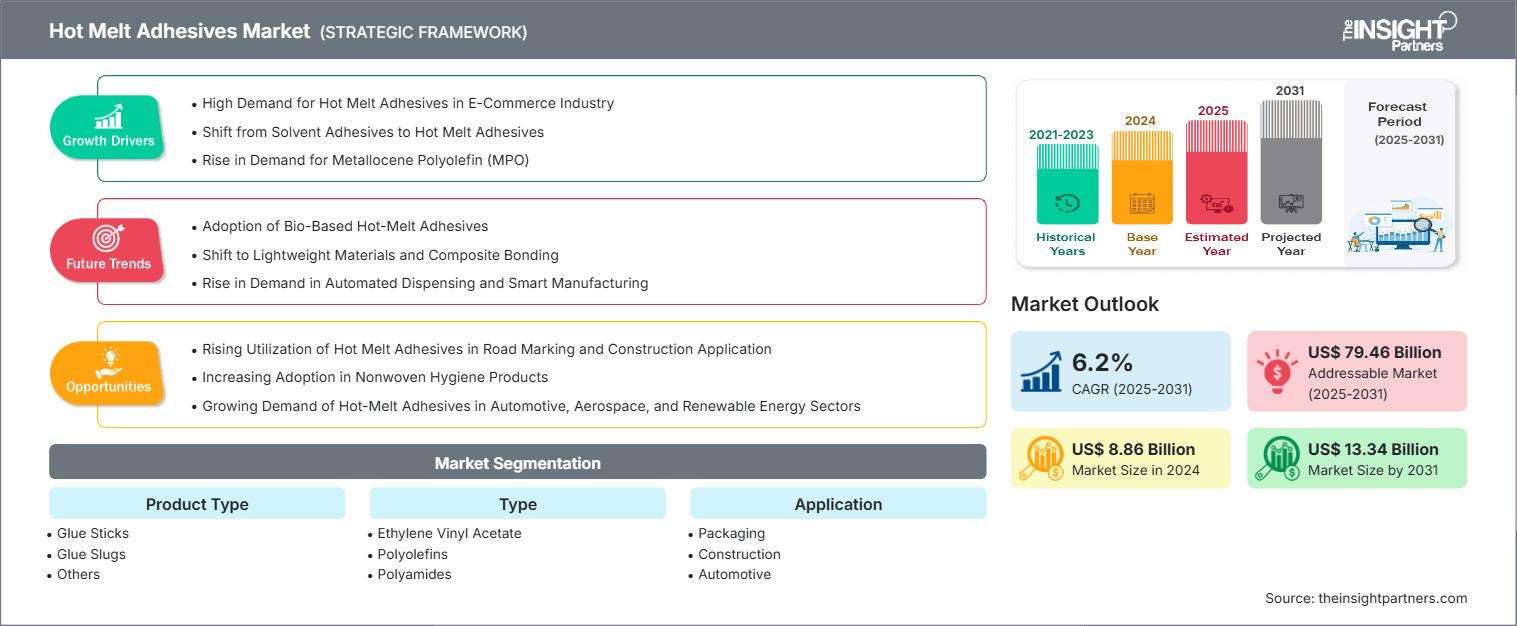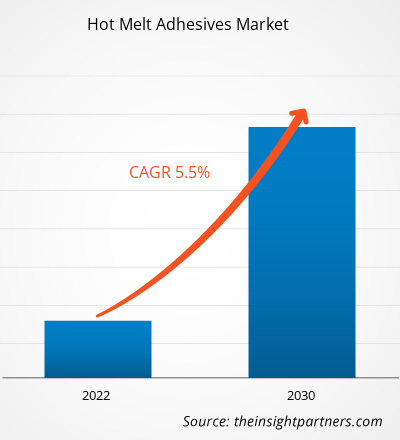热熔胶市场规模预计将从 2024 年的 88.6 亿美元增至 2031 年的 133.4 亿美元。预计 2025 年至 2031 年期间该市场的复合年增长率将达到 6.2%。
热熔胶市场分析
在一系列工业应用和技术创新的推动下,全球热熔胶市场正在稳步增长。这类粘合剂以其快速粘合和用途广泛的特点,在包装、汽车、电子、建筑和卫生行业得到广泛应用。
热熔胶市场概况
电子商务的蓬勃发展显著增加了包装行业的需求,而热熔胶能够支持该行业更快的生产和自动化。此外,与溶剂型产品相比,热熔胶的挥发性有机化合物排放量更低,有助于促进可持续发展。技术的进步也增加了热熔胶的种类,并催生出一些创新产品,使其能够实现更高的粘合强度、低温操作性能以及与各种基材的兼容性。
您将获得任何报告的免费定制,包括本报告的部分内容、国家级分析、Excel 数据包,以及为初创企业和大学提供优惠和折扣
热熔胶市场:战略洞察

-
获取此报告的顶级关键市场趋势。此免费样品将包括数据分析,从市场趋势到估计和预测。
热熔胶市场驱动因素和机遇
市场驱动因素:
- 多种用途刺激全球需求:热熔胶市场在包装、汽车、建筑和纺织领域有着广泛的用途,从而导致全球需求量很大。
- 电子商务的增长增加了包装粘合剂的需求:电子商务的快速增长推动了高效包装粘合剂的使用增加,从而导致物流和零售行业的热熔胶市场扩大。
- 可持续发展趋势推动粘合剂的环保性:消费者和监管机构对可持续发展的兴趣日益浓厚,推动了各个行业低 VOC、可回收和生物基热熔胶的发展。
- 自动化的采用提高了制造过程的效率:自动化生产线应用的增加对热熔胶的需求更大,因为它们具有快速粘合和高效的特性。
市场机会:
- 亚太市场增长前景看好:亚洲在工业基础和基础设施方面的投资不断增加,为热熔胶制造商提供了有利可图的商机。
- 可生物降解和可回收粘合剂技术的创新:随着消费者和监管压力的增加,创新、环保和可持续的粘合剂有望扩展到新的细分市场。
- 低温和喷涂胶产品创新:通过引入可用于低温工艺和喷涂应用的先进配方,进一步增加了最终用途。
- 电子组装和消费品中的应用日益广泛:热熔胶在电子粘合和耐用消费品中的使用提供了新的收入来源。
热熔胶市场报告细分分析
为了更清晰地了解热熔胶市场运作方式、增长潜力和最新趋势,我们将市场细分为不同的细分领域。以下是大多数行业报告中使用的标准细分方法:
按产品类型:
- 胶棒:它们在工艺品、学校和办公室中得到很好的应用,并且最适合用于易于熔化、涂抹和粘合纸张、织物和轻质材料。
- 胶块:高强度致密颗粒非常适合自动装配线,因为它们具有快速凝固时间、一致的粘度以及对塑料、木材和金属基材的强力粘合力。
- 其他:此部分涵盖散装块、双组分棒和微粉,适用于特定的工业应用,例如鞋类、电子产品和重型建筑粘合。
按类型:
- 乙烯醋酸乙烯酯
- 聚烯烃
- 聚酰胺
- 聚氨酯
- 苯乙烯嵌段共聚物
-
其他的
按应用:
- 包装
- 建造
- 汽车
- 家具
- 鞋类
- 电子产品
- 其他的
按地理位置:
- 北美
- 欧洲
- 亚太地区
- 中东和非洲
- 南美洲和中美洲
随着建筑、汽车和包装等终端使用行业的扩张,亚太热熔胶市场仍然至关重要。
热熔胶市场区域洞察
Insight Partners 的分析师已详尽阐述了预测期内影响热熔胶市场的区域趋势和因素。本节还讨论了北美、欧洲、亚太、中东和非洲以及南美和中美等地的热熔胶市场细分和地域分布。
热熔胶市场报告范围
| 报告属性 | 细节 |
|---|---|
| 2024年的市场规模 | 88.6亿美元 |
| 2031年的市场规模 | 133.4亿美元 |
| 全球复合年增长率(2025-2031) | 6.2% |
| 史料 | 2021-2023 |
| 预测期 | 2025-2031 |
| 涵盖的领域 |
按产品类型
|
| 覆盖地区和国家 |
北美
|
| 市场领导者和主要公司简介 |
|
热熔胶市场参与者密度:了解其对业务动态的影响
热熔胶市场正在快速增长,这得益于终端用户需求的不断增长,而这些需求的驱动因素包括消费者偏好的不断变化、技术进步以及对产品优势的认知度不断提高。随着需求的增长,企业正在扩展产品线,不断创新以满足消费者需求,并抓住新兴趋势,从而进一步推动市场增长。

- 获取热熔胶市场主要参与者概览
热熔胶市场份额地域分析
亚太地区热熔胶市场正在显著增长。南美和中美以及中东和非洲等新兴市场为热熔胶供应商提供了尚未开发的扩张机会。
由于建筑活动激增、制造业技术进步以及汽车行业的增长,各地区热熔胶市场的增长情况各有不同。以下是各地区市场份额和趋势的总结:
1. 北美
- 市场份额:占据全球市场很大份额
-
关键驱动因素:
- 蓬勃发展的电子商务行业
- 不断发展的汽车行业
- 建筑业和基础设施建设不断增长
- 趋势:环境法规推动可持续粘合剂产品开发
2.欧洲
- 市场份额:由于汽车和航空航天业的扩张,市场份额大幅增加
-
关键驱动因素:
- 利润丰厚的汽车、航空航天和电子行业
- 政府对环保材料使用的严格规定
- 制造工艺的创新
- 趋势:热熔胶在包装和航空航天工业中的应用
3. 亚太地区
- 市场份额:增长最快的地区,市场份额每年都在增长
-
关键驱动因素:
- 快速的工业化和城镇化
- 汽车和电子行业
- 政府支持的基础设施和制造业发展
- 趋势:建筑和制造业的需求不断增长
4.中东和非洲
- 市场份额:市场稳步增长
-
关键驱动因素:
- 不断增长的工业投资和城镇化
- 建筑业的发展
- 趋势:制造能力的扩大和市场渗透力度的加强
5. 南美洲和中美洲
- 市场份额:虽然较小,但增长迅速
-
关键驱动因素:
- 汽车和制造业的需求不断增长
- 城市化和区域工业化不断发展
- 趋势:通过采用新的生产方式和技术而出现的机遇
热熔胶市场参与者密度:了解其对业务动态的影响
市场密度高,竞争激烈
由于 HB Fuller Company、Henkel AG & Company KGaA、Arkema、3M、Sika AG、Jowat SE、Hexcel Corporation、The Dow Chemical Company、Gorilla Glue Company 和 DIC CORPORATION 等老牌企业的存在,竞争十分激烈。
这种激烈的竞争促使企业通过以下方式脱颖而出:
- 开发低温生物基粘合剂配方,优先考虑可持续性并与传统产品区别开来
- 开发具有智能性能添加剂的产品,例如抗菌剂或导电性增强剂,以及优质、专用的粘合解决方案
- 与自动化设备原始设备制造商合作,分销完全可调的完整热熔胶分配系统
机遇与战略举措
- 推出生物基粘合剂生产线
- 实现低温粘合剂生产的本地化
- 与电商巨头合作
- 开发复合粘合解决方案
- 投资自动分配技术
在热熔胶市场运营的主要公司有:
- HB Fuller公司
- 汉高股份公司
- 阿科玛
- 3M
- 西卡股份公司
- 胶王公司
- 赫氏公司
- 陶氏化学公司
- 大猩猩胶水公司
- DIC株式会社
免责声明:以上列出的公司没有按任何特定顺序排列。
研究过程中分析的其他公司:
- 巴斯夫
- 阿什兰全球控股公司
- 艾利丹尼森公司
- 德莎
- 汉高公司
- RPM国际公司
- 瓦克化学股份有限公司
- Soudal NV
- Resibras Química
- 化学克朗
热熔胶市场新闻及最新发展
- HB Fuller 公司 – 并购新闻 HB Fuller 公司宣布收购 ND Industries Inc.,后者是一家领先的特种粘合剂和紧固件锁定和密封解决方案供应商,为汽车、电子、航空航天和其他行业的客户提供服务
- Jowat 的 Jowatherm PUR 630.30:多功能热熔胶 Jowat SE 开发了 Jowatherm PUR 630.30,这是一款低粘度、广谱粘合的粘合剂,非常适合汽车行业等多种层压应用。Jowatherm PUR 630.30 的一大特点是其优异的耐洗性,即使在高应力下也能确保持久可靠的粘合。
热熔胶市场报告覆盖范围和交付成果
《热熔胶市场规模及预测(2021-2031)》报告对市场进行了详细分析,涵盖以下领域:
- 范围内涵盖的所有细分市场的全球、区域和国家层面的热熔胶市场规模和预测
- 热熔胶市场趋势以及市场动态,例如驱动因素、限制因素和关键机遇
- 详细的波特五力分析和 SWOT 分析
- 热熔胶市场分析涵盖市场趋势、全球和区域框架、主要参与者、法规和最新市场发展
- 行业格局和竞争分析,涵盖市场集中度、热图分析、知名企业以及热熔胶市场的最新发展
- 详细的公司简介
- 历史分析(2 年)、基准年、预测(7 年)及复合年增长率
- PEST和SWOT分析
- 市场规模、价值/数量 - 全球、区域、国家
- 行业和竞争格局
- Excel 数据集
近期报告
相关报告
客户评价
购买理由
- 明智的决策
- 了解市场动态
- 竞争分析
- 客户洞察
- 市场预测
- 风险规避
- 战略规划
- 投资论证
- 识别新兴市场
- 优化营销策略
- 提升运营效率
- 顺应监管趋势






















 获取免费样品 - 热熔胶市场
获取免费样品 - 热熔胶市场